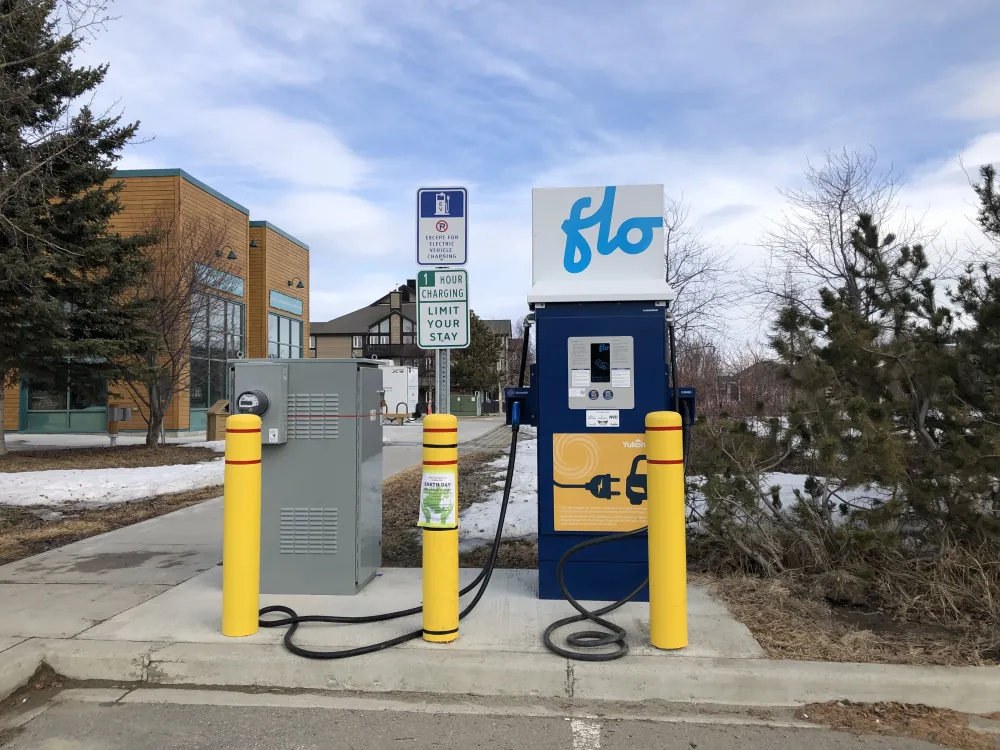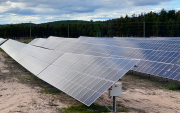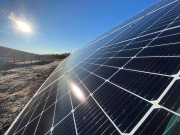This is the tenth publication in Climate and energy policy advancements: Eliminating diesel in Canada’s remote communities, a series providing insights, details, and analysis of each of the specific policies we advocate for under our Renewables in Remote Communities (RiRC) program and the Indigenous Off-diesel Initiative (IODI).
The decarbonization of transportation systems is crucial to reducing diesel reliance and achieving Canada’s net-zero targets. In many northern and remote communities, transportation-related emissions represented over half of total greenhouse gas (GHG) emissions in 2019.
As part of its emissions reduction plan, the Government of Canada has committed to reducing carbon emissions from transportation by up to 18 mega tonnes per year by 2030. This emissions reduction is set to be achieved in part through zero-emission vehicle (ZEV) sales mandates so at least 20 per cent of new passenger vehicles sold in Canada will be ZEVs by 2026, 60 per cent by 2030 and 100 per cent by 2035. This will be supported through ZEV consumer incentive programs and incentivized by the implementation of the Clean Fuel Regulation (CFR), which among many things, improves the business case and technology availability for charging infrastructure and low-carbon fuels.
There is notable opportunity under these new regulations for a low-carbon transportation industry, but considering the unique constraints posed by remoteness, this transition will look different for remote communities than it will for urban communities and large cities. Colder climates, limited access to renewable electricity, limited grid capacity and limited market-ready electric vehicle (EV) options for the larger passenger vehicles more commonly relied upon in northern communities are just a few of the unique challenges remote communities face on their path to EV adoption.
In the territories, EVs make up about 0.1 per cent of new vehicle sales. Most communities in this area are able to count the number of EV’s on one hand, that is if they can count them at all. The Yukon is a leader in the EV transition for the territories taking advantage of its access to renewable energy. Eighty per cent of Yukon’s electricity is supported through hydropower, compared to Nunavut which is almost entirely diesel dependent. In the Northwest Territories, 72 per cent of electricity was generated from renewables in 2020. As a part of the Yukon’s Our Clean Future Plan, the government established its own ZEV sales goals of 10 per cent by 2025 and 30 per cent by 2030; this translates to getting 4,800 EVs on the road by 2030.
Remote communities are increasingly interested in EVs, but they face a unique set of constraints in the transition. Northern, Indigenous and remote communities will need new tailored support from government to fully participate in the EV transition and decarbonize local transportation systems. Equitable opportunities to participate will need to be supported through government programming and policy that recognizes and the additional constraints faced by remote communities.
Cold climates affect vehicle ranges
A vehicle is considered a ZEV if it does not produce any harmful air pollutants and GHG emissions at the tailpipe. For light-duty vehicles, like cars and other small passenger vehicles, and for some classes of medium- and heavy-duty vehicles, like buses, battery-powered EVs are among the most prevalent, commercially available type of ZEV. However, in cold climates, battery-powered vehicles face range degradation. When temperatures drop below –20 °C, range can decrease by up to 50 per cent, bringing the average range down from 400 km to 200 km. In remote regions the electrical infrastructure to support charging stations is limited, or simply doesn’t exist in the sometimes 200 km to 300 km stretch between communities.
For many remote communities though, reduced vehicle range is less of a concern because they do not have very extensive road infrastructure. This is especially true in communities that are fly in only. Vehicles here are mostly used for travel within the community, potentially making them good candidates for EV ownership.
Plug-in hybrid EVs (PHEVs) are powered by a combination of electricity and an internal combustion engine, this extends the range of EVs and makes long-distance driving a possibility. PHEVs will be included under Canada’s ZEV mandate and are a part of purchase incentive programs. These vehicles still generate emissions from the use of their internal combustion engines but could serve as a bridge between combustion engines and full battery powered EVs, making them a crucial intermediary in remote communities to allow for EV technology and electrical infrastructure to catch up.
Dated and diesel dependent grids complicate the transition, but do not make it impossible
The number, placement and class of charging stations will play a key role in attracting drivers to make the switch. EV charging infrastructure in remote communities is currently lacking, according to PlugShare , a crowdsourced charging station map. Of the over 6,000 public charging stations across Canada, only 13 of them are in the territories. While there are a few remote communities, especially in B.C., considering adopting charging stations, the infrastructure is still a little too thin to make owning an EV as a primary vehicle viable.
Recent announcements at both the federal and territorial levels recognize the need for increased funding and government programs for EV charging infrastructure. The Yukon government committed funding towards the installation of 14 more fast chargers in remote Yukon locations to facilitate inter-community transit.
New funding announced by the federal government in July of 2022 will support the installation of up to 72 EV charging stations throughout the Northwest Territories. The Government of the Northwest Territories also has plans to deploy EV chargers from the Yellowknife to the Alberta border. These announcements are positive ones for remote communities, however funding towards infrastructure is limited, as such, the intent of these programs more broadly is to spur private investment in EV infrastructure.
Costs to install EV chargers in some communities can be disproportionately high. Dated electricity generation and distribution infrastructure and supply chain challenges are a reality and need to be considered in funding programs. Canada’s recently released CFR improves that business case by allowing charging station proprietors to sell credits from supplying electricity used for charging. However, if governments want to encourage private investment in charging infrastructure in these communities, more support will be needed.
Investment into EV charging infrastructure and rebate programs is being prioritized in remote communities that have access to renewable energy, but many northern and remote communities rely substantially on diesel generators for their electricity needs.
Operating an EV results in no tailpipe emissions, however driving an EV may not be completely emissions free. Many regional grids consist, at least in part, of diesel-powered electricity, meaning some emissions will still be associated with EV use. EVs are more energy efficient than internal combustion engines, so even on Canada’s most intensive regional grid systems, the use of EVs will result in emissions savings. However, many remote communities do not have grid-connection and rely on diesel-powered generators for their electricity. In this case, there are marginal, if any, GHG reductions that come from running an EV, compared to operating a car with an internal combustion engine.
Exploring pairing EV charging stations with on-site renewable energy generation as well as a battery storage system could be a solution to this problem. Gull Bay First Nation in northern Ontario is piloting this concept and is seeing good results. They have installed a solar hybrid EV charging station by outfitting their band office with solar panels and on-site battery storage. The station is now operational and offers free charging to users.
The use of biofuels in transportation is another path to reduce diesel consumption and GHG emissions that come with a bonus: their use does not increase strain on diesel infrastructure. However, the availability of biofuels that remain stable at cold temperatures is still low. More supply will be needed to increase their use in northern and remote communities.
Programs should be tailored to community-specific needs
When it comes to vehicle affordability, EVs are out of reach for many, and this is even more true for residents in remote communities. The federal government does have rebate programs to support upfront vehicle costs for small and large vehicles, as well as charging infrastructure. Some jurisdictions also offer stackable rebate programs; however, these regional programs can be limited in funding, and are unable to provide rebates to all interested parties.
The NWT had an EV incentive program running through the Arctic Energy Alliance that was not renewed in 2022 due to limited funds. Funding and incentive programs should be designed to recognize the higher financial barriers faced by residents in remote communities and should consider prioritizing plug-in EV adoption given their unique applicability to the challenges of remote communities.
Implementing local strategies like an EV first procurement policy for government vehicles or fleet electrification are effective ways to introduce EVs to communities that take advantage of current policy opportunities and work around some of the barriers to EV adoption. This is something that is also being explored elsewhere in Canada; a Pembina report looks at electric bus procurement targets in B.C., the recommendations from this report could be equally relevant in many remote communities.
Focusing on the electrification of vehicles intended for in-community use avoids the need for long ranges and widespread charging infrastructure. Fleet vehicle electrification is well suited to take advantage of the credit system under the CFR in order to support financing. Ultimately, there is the overarching need for remote community grids to get off diesel – and funding needs to be continually directed towards supporting communities in the development of more renewable energy projects.
Funding and policy priorities should account for the additional constraints remote communities face
In Canada’s remote communities, an EV transition will look different than it will in grid connected communities. As part of the federal government’s introduction of a ZEV mandate, they commit to consulting Inuit and Northern communities to address the barriers to ZEV uptake in remote regions. This commitment should be followed through and active efforts to address these barriers should be prioritized so remote communities can access equitable decarbonization opportunities for transportation.
There is no one-size-fits-all approach in this transition – remote communities have access to different resources and have unique transportation needs. When introducing policies and programs that promote ZEVs, governments should keep these communities and their specific needs in mind to ensure they are part of the transportation decarbonization process, if not leading it.
Additional reading
- Electric Vehicles in Rural and Remote Communities: Identifying Opportunities, Understanding Challenges
- Electric Vehicle Infrastructure Needs Assessment And Forecast
- Canada’s forthcoming Clean Fuel Regulations

Climate and energy policy advancements: Eliminating diesel in Canada’s remote communities
Publications in this series:
- Rethinking energy policy in Canada’s remote communities
- How to boost renewable energy integration in remote communities
- What’s a fair and equitable price for renewable energy in remote communities?
- Better government policies will unlock the cash remote Indigenous communities need for clean energy
- Reducing emissions from diesel generators in remote communities
- When business-as-usual is a barrier to clean energy
- From diesel dependency to energy empowerment
- Three clean energy options that could help replace diesel
- Remote communities transitioning to clean energy need better housing
- How remote communities should be included in the push to electrify transportation
- Government action on UNDRIP and the clean energy transition









